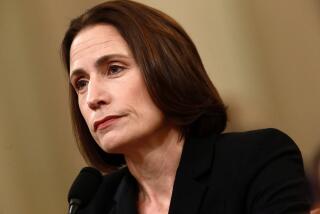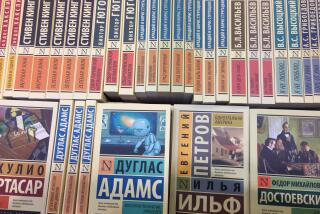THE OPENING QUESTION
- Share via
As consummate members of America’s foreign-policy clique, William Hyland and Thomas Simons enjoy a more cloistered life than do their counterparts in most Western European democracies, where foreign affairs generate greater interest and thus greater scrutiny. They might talk to ordinary Americans on TV news shows, but they rarely hear from them in the interim.
This lack of public accountability, to be sure, hasn’t turned either of these authors into a wild-eyed warmonger a la “Dr. Strangelove.” Simons, U.S. ambassador to Poland, writes with a humility befitting his role as mid-level diplomat (“I’m not a leader; what follows is very much a bricklayer’s song”), while Hyland, editor of Foreign Affairs Quarterly and former member of the CIA, offers an impressively clear, rhetoric-free analysis that follows from his unsentimental view of the world as chess game rather than morality play.
Like members of any exclusive clique, however, both authors often arrive at conclusions before analyzing premises, and then present their opinions as facts. That many of us also accept their conclusions as facts suggests that America could use its own dose of the glasnost both authors predictably hail overseas.
Hyland’s book is the more closely argued, offering a concise analysis of Cold War logic that will surprise those accustomed only to Cold War polemics: Khrushchev’s attack on Stalin’s reputation thus is seen more as policy failure than moral triumph (for it was to weaken the Soviet empire), while Stalin’s alliance with Hitler wins praise for deflecting a Japanese attack, not scorn for its moral turpitude.
Simons’ arguments--a bit flippant coming from someone who recently has been praised by top diplomats from George Shultz to George Bush--are based on his fear that Americans will retreat into the kind of isolationism they favored under Woodrow Wilson. Warning that most Soviets, like most Americans, still “carry the Cold War around with them,” he finds it “theoretically shaky” to argue that simply because the Soviets need to focus on solving domestic problems, they will do so. Gorbachev might choose to exercise a more muscular foreign policy despite its costs, for “there are always costs in politics.”
This strained reasoning simply isn’t enough to justify a continued military buildup against the Soviets, however, and potentially persuasive arguments, such as likely scenarios of how and why the Soviets might decide to attack, are never offered. Most of Simons’ arguments, in fact, seem conjured in the days before the tumbling of the Wall, when simple rhetoric often did capture the reality.
He says America has “the most open political system in the world,” for instance, and views the Soviet Union as our opposite, for there, the state continues to “impose societal uniformity.” Even many American conservatives, however, would acknowledge that Soviet citizens are now debating the fundamental nature of their society, while the American political system has become more closed than ever before to those who cannot secure sizeable funds from the most affluent members of society.
Both authors say they have written their books in the hope that reviewing our confrontational past will shed light on the problems of our cooperative present. But neither book ends up offering lessons that address the unique and pressing problems of the post-Cold-War era, such as preventing the Saddam Husseins of the world from developing nuclear arsenals, or combining the economic dynamism of American capitalism with the durable social security of socialism.
Perhaps our analysts as well as our armaments might need to be “retooled” for the new era.


